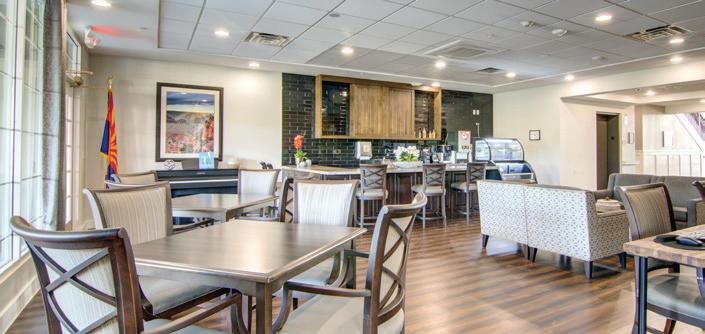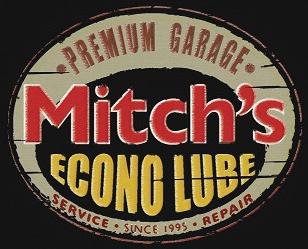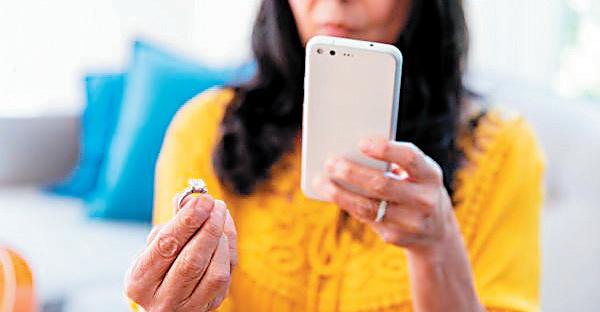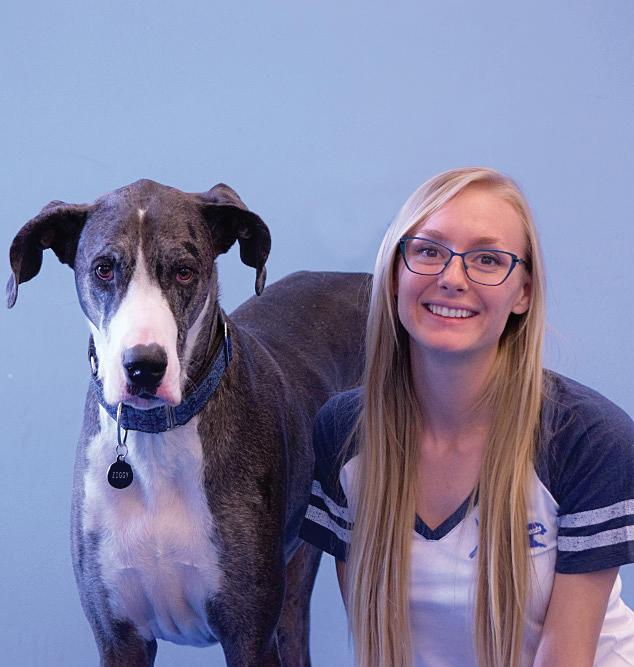
11 minute read
Real Estate
RESIDENTIAL REAL ESTATE BE HOMESMART THE BATSON TEAM – FROM OUR VIEWPOINT
By Al and Jean Batson
Montreux Update (from Statesman Builders) about their pre-leasing schedule: Construction is on target for move-ins late Spring 2019, with their second and fi nal building slated for moveins August and November 2019. The Montreux pre-leasing offi ce trailer is now open. Marketing material and fl oorplans are now available. Their fl oorplans will range from 803 square feet – 1,517 square feet with rents starting at $1475 per month.
PROTECTING YOUR HOME AND SAFETY:
Last month we talked about having your “ducks in a row” insofar as having your legal documents current – do you have a Will or Trust? Healthcare Directives? This month we’re delving a little more into safety in your home; personal and property safety.
Our resources indicate that the majority of home burglaries happen during the daytime when people are at work. This has been said many times before, but we all need to take steps to protect our homes and be observant. Posting on the NEXTDOOR website has been very helpful. There have been postings of suspicious vehicles and people complete with details. Keep your valuables in a safety deposit box at your bank; or if you’re going to have a personal safe, be sure it is fi re and waterproof and very heavy so a burglar can’t just pick it up.
Today, exterior AND interior cameras are popping up everywhere as evidenced by the news showing those “porch pirates” stealing packages. It’s become an epidemic. If you work all day, can those packages be delivered to your workplace? Or to a stay-at-home neighbor? Cameras are certainly helping the Police in identifying these thieves and sometimes can be a deterrent. RING video door bells seem to be the rage. It might be worth looking into. And rear yard/ patio cameras showing other areas of access would also be a good place to place them.
Vehicles have also been a rising statistic; so many times, they hit at night when cars are parked on the street or in a driveway. They go fi rst for those left unlocked and/or those with obvious valuables to steal. If your garage is full of “stuff,” maybe it’s time to clean out and organize so your vehicles can be parked safely inside. Always be sure there are no valuables in your vehicle and the car is securely locked. Make it at least a little diffi cult. When your vehicle is outside, please be sure your garage door opener is not in view. Put it in the glove box or a side pocket rather than on the visor. Thieves love to break the window, get your address from your registration (you can legally redact your address) and head to your home to rob it. We have friends that experienced that when they were visiting someone at the hospital. The thief saw them go in, broke in, got their address and headed over to clean out the house while they were gone. Get an alarm system – and use it. Most burglars will pass on a home that is posted to have alarm protection and head to one that doesn’t. Exterior motion lights can be helpful as well. Make sure windows are closed and locked and patio doors have a pole in the door track. A security front door screen is also helpful in putting another layer between you and whomever is at your door. There are screens that can’t be cut through which are expensive, but valuable.
Start a Neighborhood Block Watch – know your neighbors and keep an eye out for each other. If we’re going to be out-of-town, we notify our neighbors and mention, “If you see a truck pulled into our driveway and they’re loading furniture, please call 9-1-1 because we’re not donating the contents of our home.”

It’s sad that there are so many people who have absolutely no remorse about other people’s property or safety. All we can do is prepare for the worst and hope for the best.
If you have any questions about real estate, please email me at: Jean@


New Choice New Choice! there's a


AlandJeanBatson.com
Upscale yet affordable: the newest choice in senior living! We are redefining senior living with our distinctive stylish designs and extraordinary amenities including Tranquility Spa, Cyber Cafe and Lounge, putting green, therapy pool and private pet park.


Present this ad at your tour to be entered to win in our monthly drawing!
20221 N 29th Ave. Phoenix, AZ 85027
Call for a private tour! (623) 237-9741 DeerValleySeniorLiving.com
Wash All You Want FREE for the First 30 Days!* Unlimited “Best Wash” Membership
*$1 activation fee must be paid with a credit card. Expires 2/28/19 Valid at 2137 E. Sharon Drive Phoenix, AZ 85022 2011 E. Cactus Road Phoenix, AZ 85022 21250 N. Cave Creek Road Phoenix, AZ 85024
QuickQuack @QuickQuack
QuickQuackCarWash
www.DontDriveDirty.com 888-772-2792
QQ_EG_WashAllWant_4.92x5.16_FINAL.indd 1


12/12/18 4:21 PM
SERIOUS SKILLS, WE HAVE

STRONG WITH THE REPAIR, WE ARE Oil Changes • Mechanical & Electrical Repair • Brakes Air Conditioning • Pre-Purchase Inspections Wheel Alignment • Fluid Exchanges • Suspension Filter Replacement • Struts & Shock Absorbers Headlight Restoration • Bulb Replacement • Fuel Pumps Belts and Hoses • Water Pumps • Cooling Systems Tire Rotations • Wiper Blades • Motor Mounts • Driveline Alternators • Radiators • Batteries • CV Axles
DISCOUNT COUPONS AVAILABLE ON
WWW.OILSLINGER.COM 17217 N. Tatum Blvd. (North of Bell) (602) 404-5704 www.oilslinger.com Family Owned - Same NE Valley location since 1995
HOME INVENTORY HOW-TO By Michelle Donati-Grayman, you create a list of your belongings, AAA Arizona organized by room.
In the event of a fi re or other damage to your property, would you be able to remember all of the items you lost? Having an up-to-date home inventory can help you get back on your feet faster after a disaster.
Building a home inventory can seem like a daunting task, but doesn’t need to.
GETTING STARTED
• Make it a goal to create an inventory for one space in your house each week, such as the kitchen or entertainment center, and soon you’ll have a complete list. Document your valuables with general descriptions, cost, and when and where they were purchased. Record serial numbers, if applicable. They are usually found on the back or bottom of major appliances and electronic equipment. Then, move on to the next space you need to document.
• Make sure you have suffi cient insurance coverage for big-ticket items, such as jewelry, art and collectibles. They may have increased in value and may require an endorsement in addition to your standard homeowners or renters insurance policy. Save receipts and appraisal documents with your inventory.
• Don’t forget items that may be tucked away in a garage, attic or storage shed.


USE TECHNOLOGY TO MAKE THE PROCESS EASIER
• There are many free apps that can help • You can also use a handheld camera or the camera on your cell phone to take photos or video to document your possessions.
KEEP YOUR HOME INVENTORY UP-TO-DATE AND IN A SAFE PLACE
• Your home inventory is only useful if it is accurate and accessible when you need it. Make a habit of adding any signifi cant new purchases and receipts to your list.
• If you have a paper inventory, keep a copy somewhere outside of your home, such as in a safe deposit box or with a trusted family member or friend. Make a digital backup of your paper list by taking a picture of it, or scanning and uploading it to a cloud storage service.
• If your list is digital, keep a copy of it on an external drive or cloud storage service. Photos and video you take with your phone may automatically be saved to cloud storage. Check your mobile phone settings to be sure.
• If using an app, make sure the information you enter is backed up and that you know how to access it when you need it.
Once your inventory is created, add up the replacement costs for all of your items, and discuss your situation with your insurance agent to make sure you have the right coverage.
HOME A BEGINNER’S GUIDE TO COMPOSTING IN PHOENIX
WHAT IS COMPOST?
Compost is organic material that has decomposed. It is made by combining “green” items like food scraps and grass cuttings with “brown” items like leaves and wood chips, which then break down over time. The resulting material is nutrient-rich and can be used in gardens as a soil conditioner and natural pesticide.
WHY COMPOST?
Organic matter like food, food-soiled paper, and yard waste is more than a third of what gets thrown into the garbage. When sent to the landfi ll, it creates methane, a greenhouse gas that is 25 times more powerful than carbon dioxide. Backyard composting or with a local program protects our environment, saves landfi ll space, creates jobs, and enriches soil. And it’s easier than you might think!
PARTICIPATE IN A LOCAL COMPOSTING PROGRAM OR DIY
The City of Phoenix runs a municipal composting facility that processes yard waste. You can sign up for a curbside green bin that accepts grass clippings, branches, and shrubs. If you want to compost food and food-soiled paper, Recycled City is the area’s local community composter. For only $10/month, they accept a variety of compostable waste, such as food, meat, dairy, napkins, and paper plates, and even pet food and hair trimmings.
TYPES OF HOME COMPOSTERS
With a small investment you can turn your compostable scraps into nutrient-rich soil at home. There are


several different home composters: • Manufactured compost bins, typically made out of plastic • Compost tumblers that can be easily turned • Wooden and pallet bins with compartments • Worm composting (vermicomposting)
WHAT TO PUT IN THE COMPOST
To get started follow these steps:
Step 1: Collect your “brown” and “green” compostable material a. “Browns” – dry materials like wood chips, dried leaves, grass, and plants. It works even better when you rip or cut items into smaller pieces. b. “Greens” – fresh, moist materials like grass cuttings and food scraps.
Step 2: Put an approximately equal amount of browns and greens into your composter. To ensure that your pile does not smell, add more browns (1 part green, 2 parts brown). Step 3: Soak the pile with water, but don’t over soak. It should be as damp as a wrung-out sponge.
Step 4: Wait a week, then add water, turn, and stir the pile. Step 5: Keep adding, soaking, and stirring! Your compost should be ready in 3-6 months. Many home composting systems are not well-suited for dairy, fi sh, meats, fats, or oil/grease, as these products take longer to break down and can attract pests.
HOW TO COLLECT COMPOSTABLES IN YOUR KITCHEN
Collecting food and food-soiled paper in your kitchen doesn’t have to be a hassle. There are many types of countertop containers, which you can line with a certifi ed compostable bag, or rinse to keep clean. As you clean up, you can scrape leftovers directly into the bin. Once the container is full, dump it into your outdoor collection bin or composting system. During the warmer months, you can keep your food scraps in the fridge, where they won’t smell or attract fruit fl ies.
FIXING ISSUES LIKE ODORS OR PESTS
Home composting is easy, but there a few common issues that fi rst-time composters run into: • Funny smells? Turn the pile and add some browns • Pile too dry? Spray some water, add in greens, and mix • Fruit fl ies? Stir and add leaves or grass • Insects, raccoons, rats? There might be some meat or fatty food scraps in your bin. First, remove the meat or fats. You can also cover the pile with a heavy layer of soil, leaves or sawdust, or use an animalproof composter.
WHAT ABOUT TAKEOUT CONTAINERS AND COMPOSTABLE PRODUCTS?
If you eat out, you may bring home packaging labeled “compostable.” Containers, cups, and utensils like those made by World Centric are certifi ed compostable by BPI, a third-party certifi cation. This means a product has been tested to revert to carbon dioxide, water, inorganic compounds, and biomass at a rate similar to paper.
Compostable products can be made from renewable plant fi bers, wood paper, or compostable plastics. Products made from plant fi bers or paper are not certifi ed to break down at home, but you can experiment to see how they perform in your system. It helps to cut or rip them into smaller pieces. Compostable plastics should not be put into your home composting system, since they require higher heat to break down. Once you have an outdoor composter and a kitchen container for collecting material, you’ll be well on

your way to turning waste into black gold.
AZ Dog Sports
Training for You andYour Dog plus An AcademyFor Dog Trainers
AZDogSports.comAZDogSports.com
ObedienceObedience AgilityAgility SerService Dogsvice Dogs Dog SportsDog Sports
AZDogSmart.comAZDogSmart.com
We train trainersWe train trainers








